The image of leader in the Russian cartoons
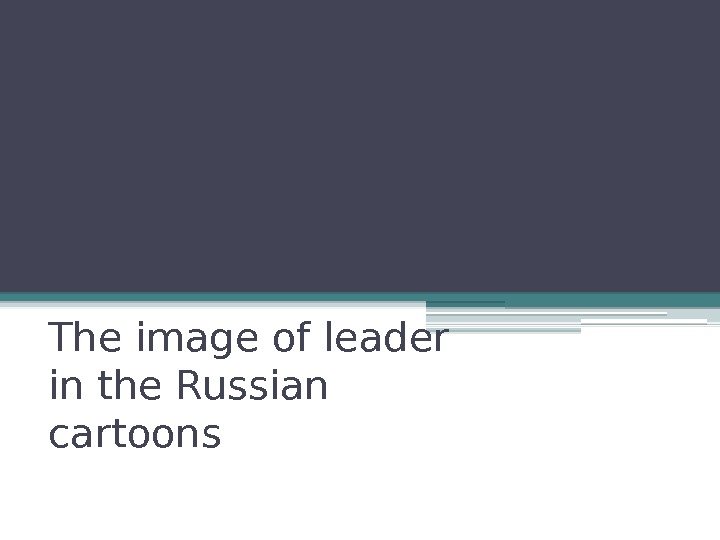
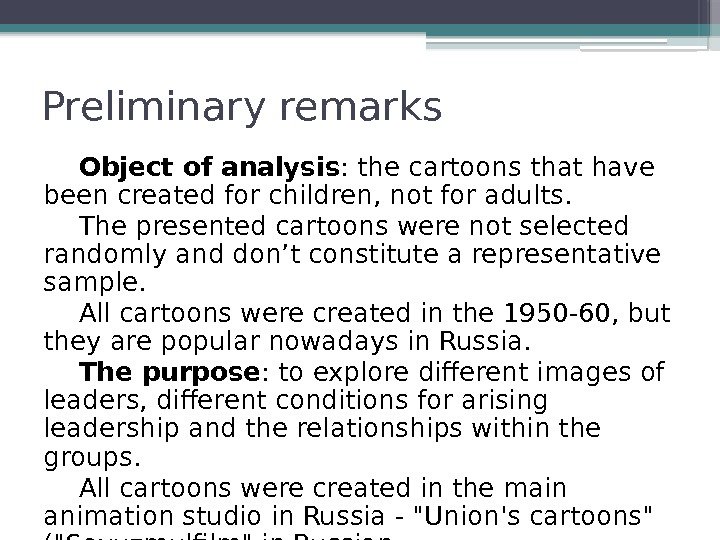
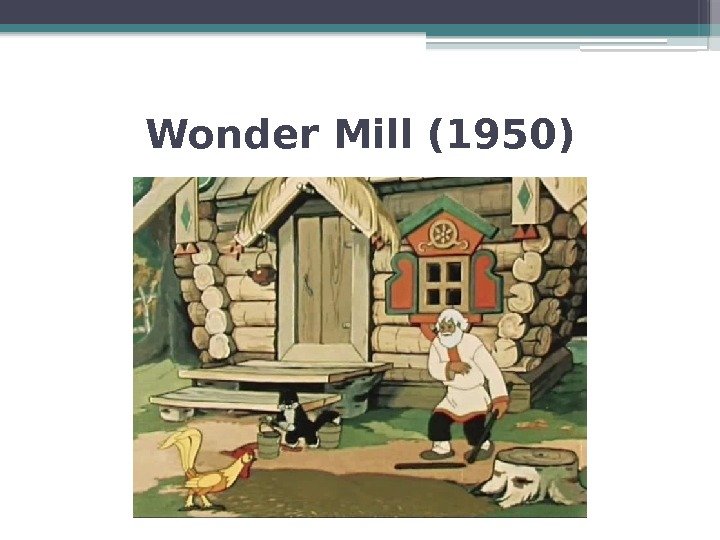
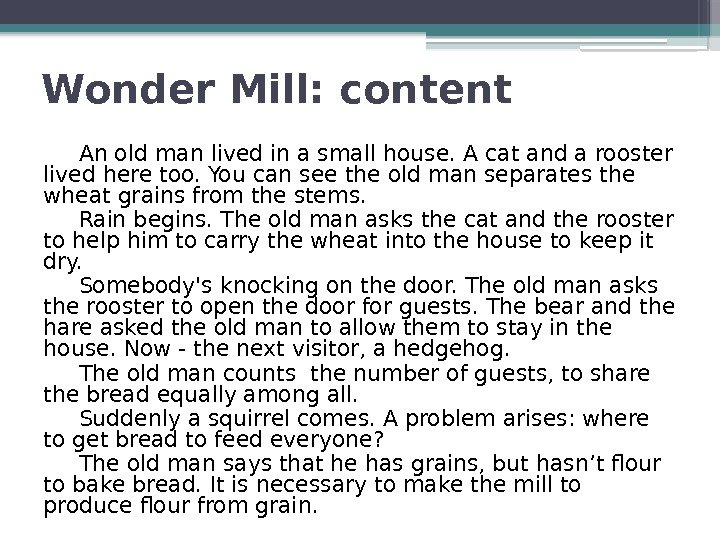
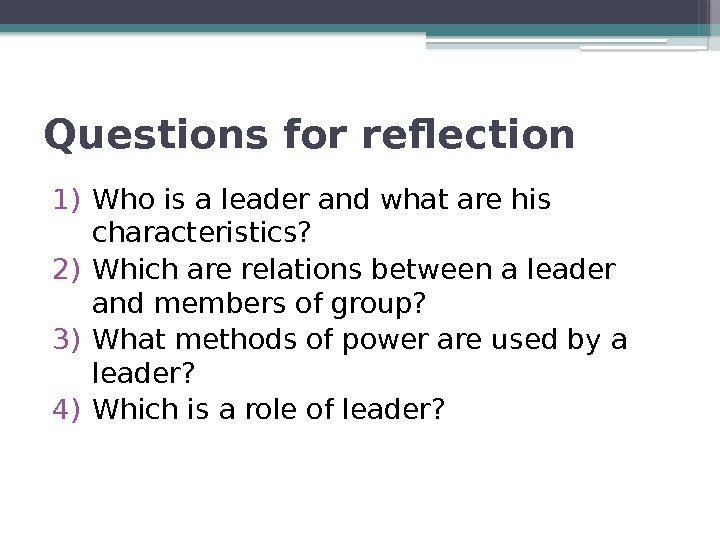
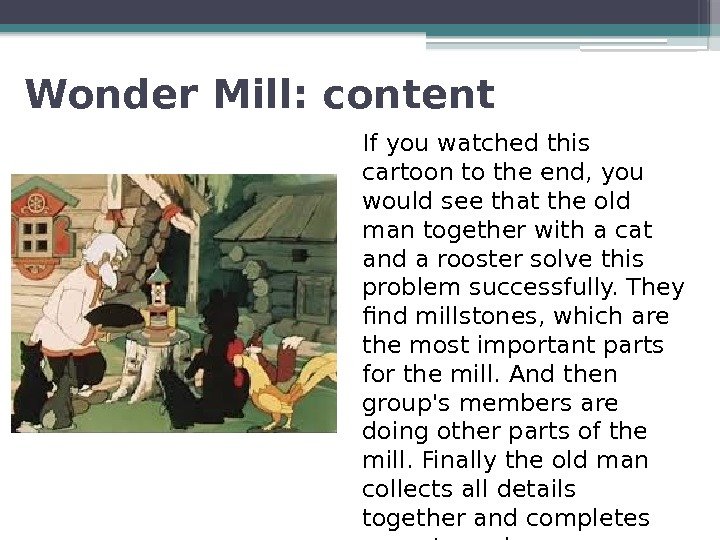
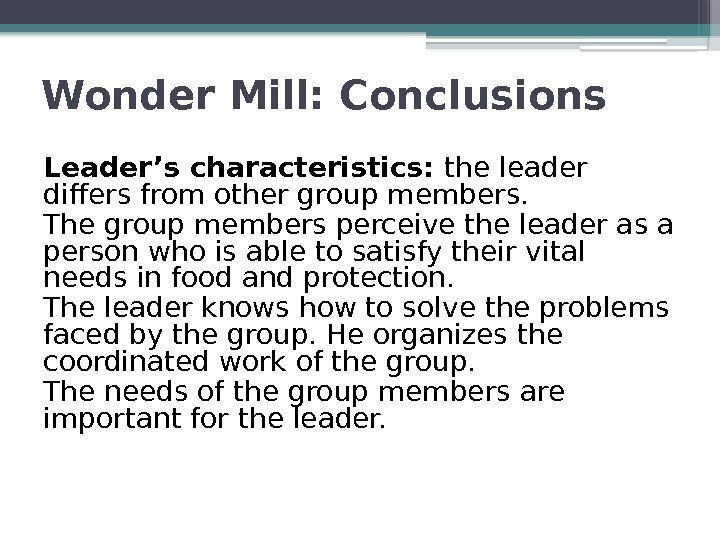
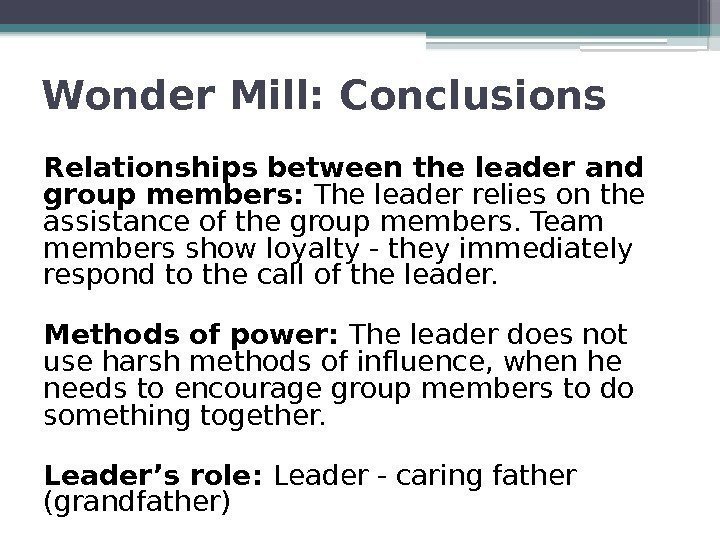
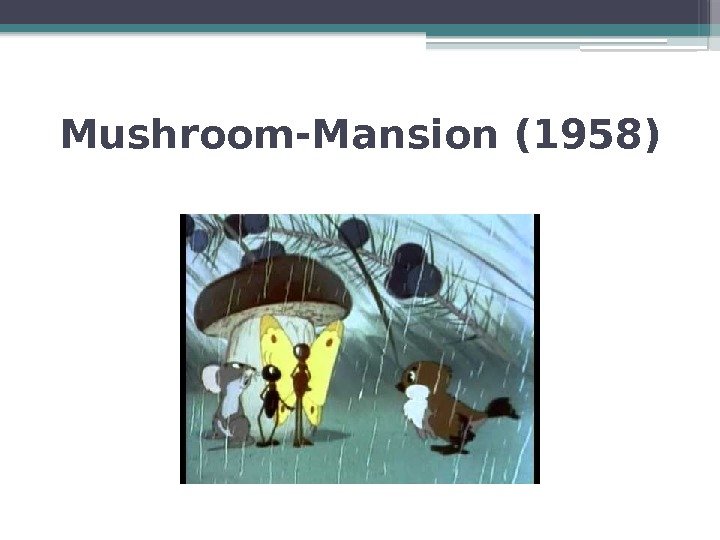
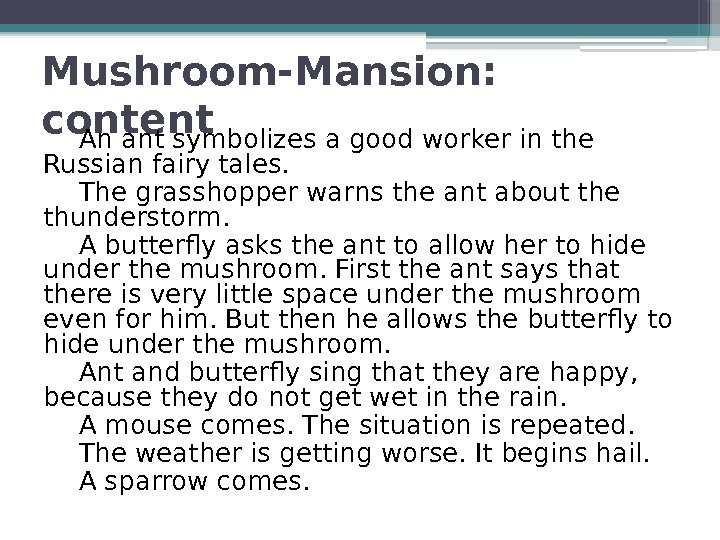
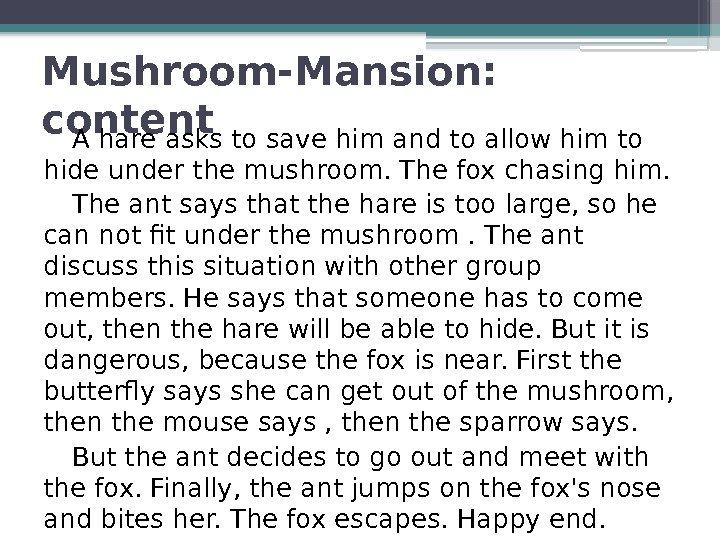
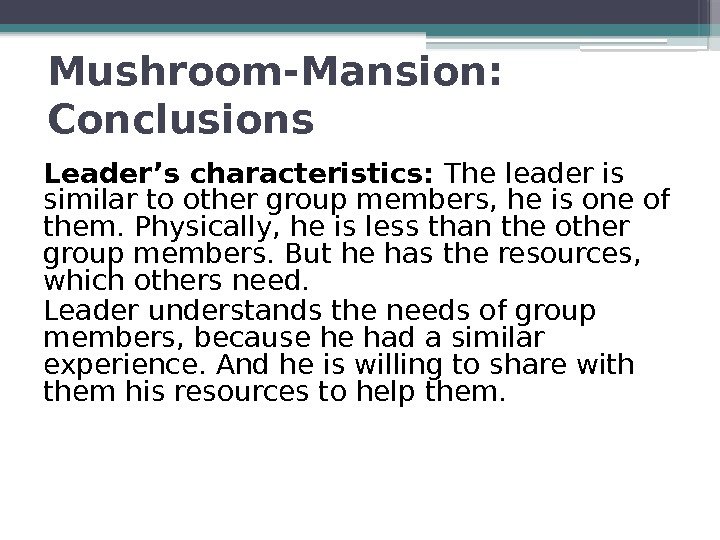
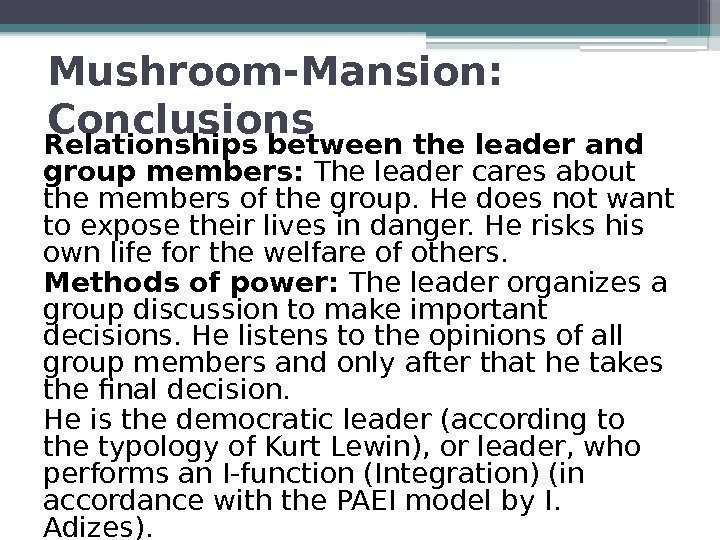
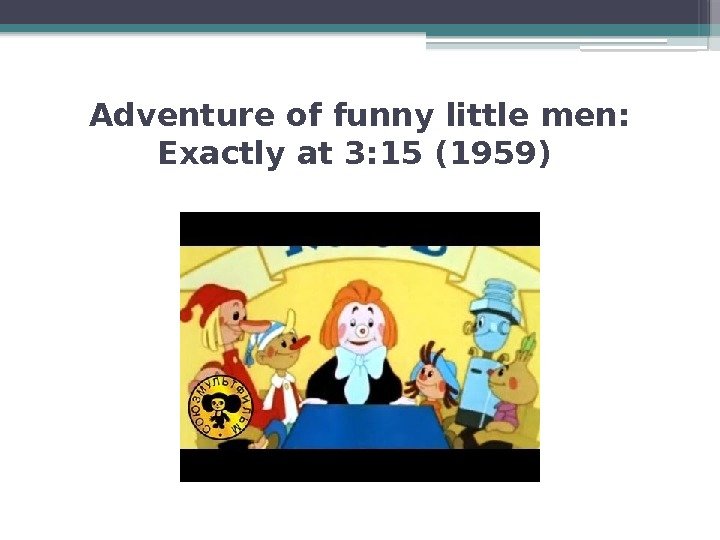
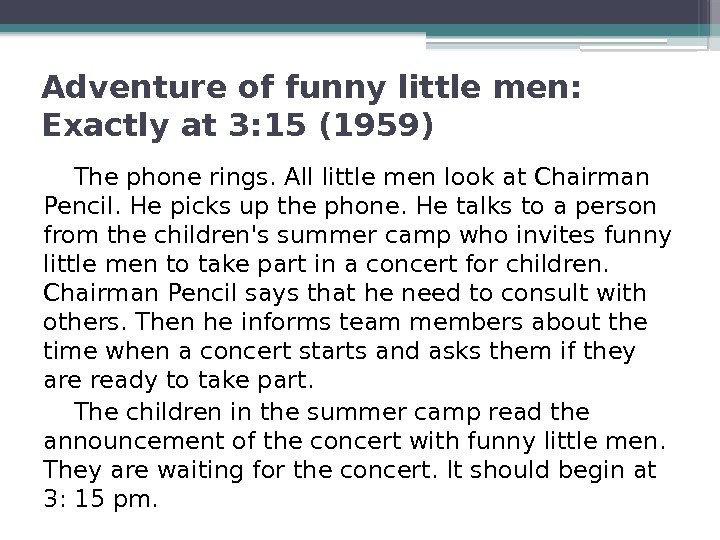
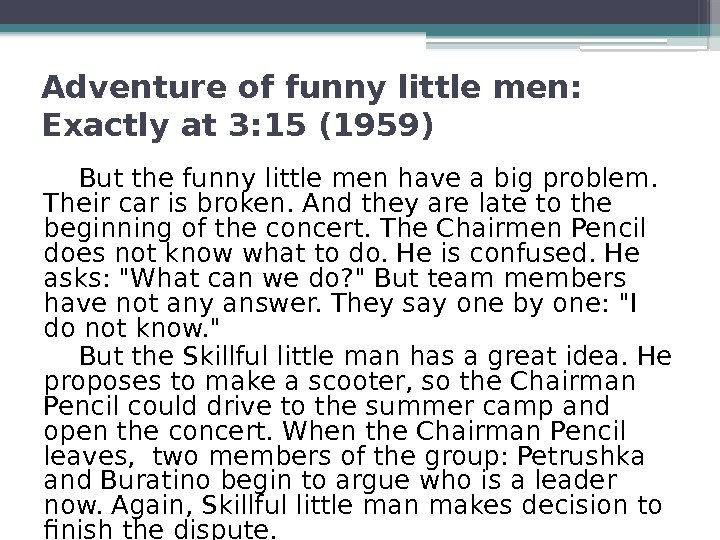
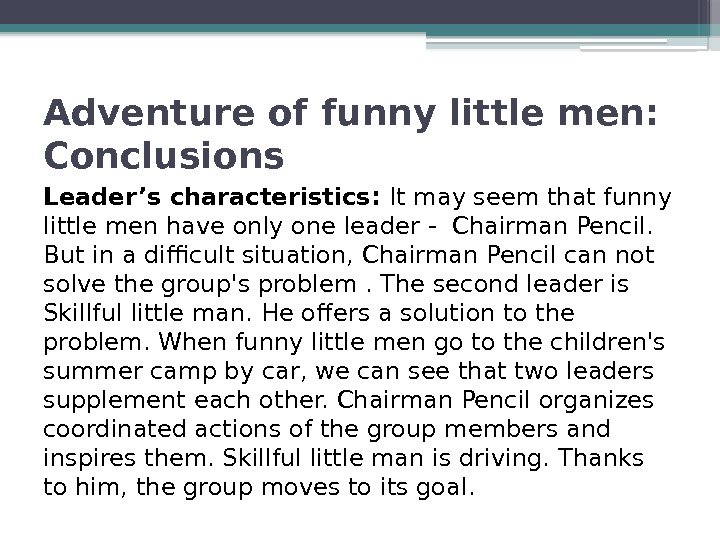
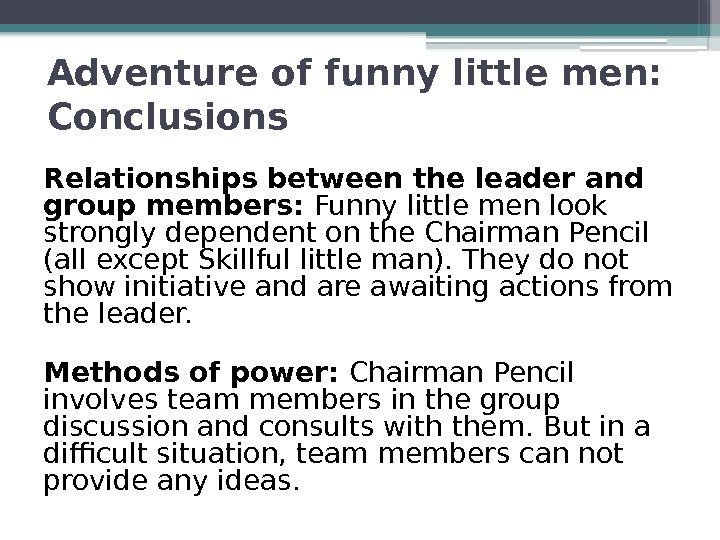
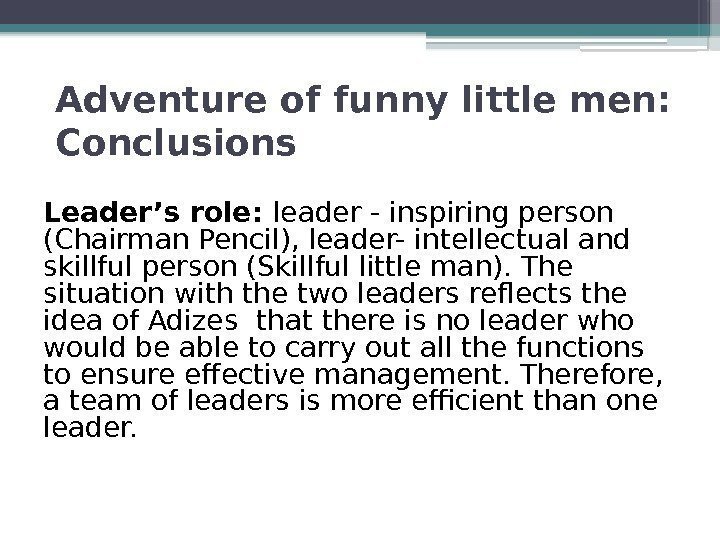
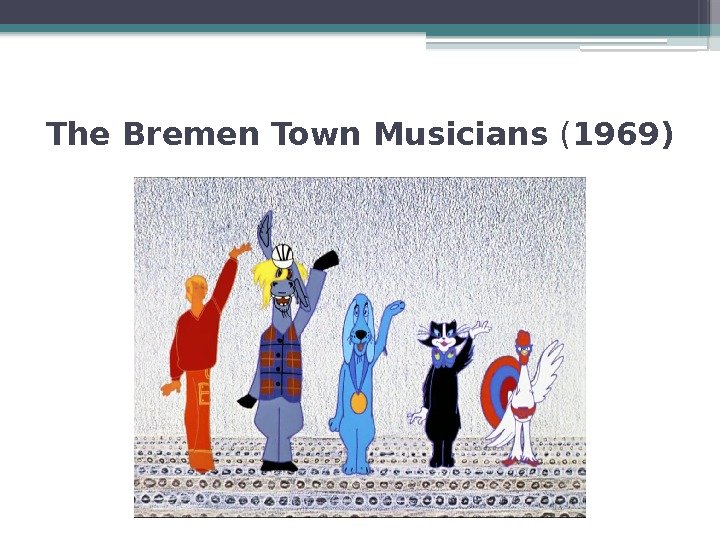
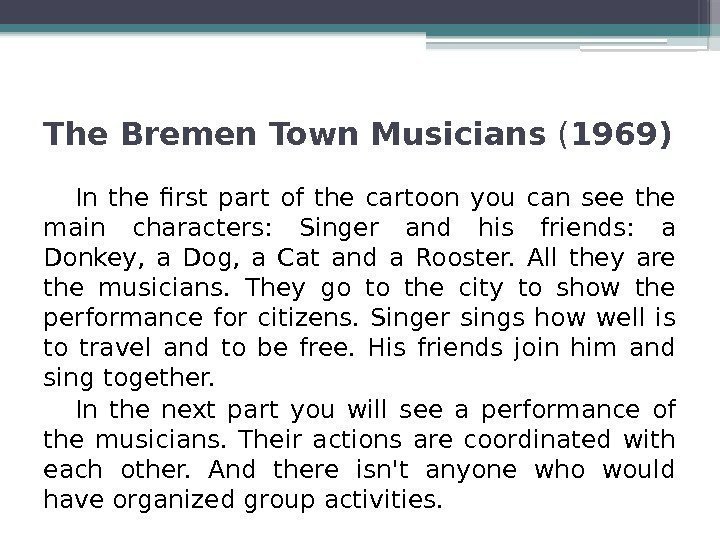
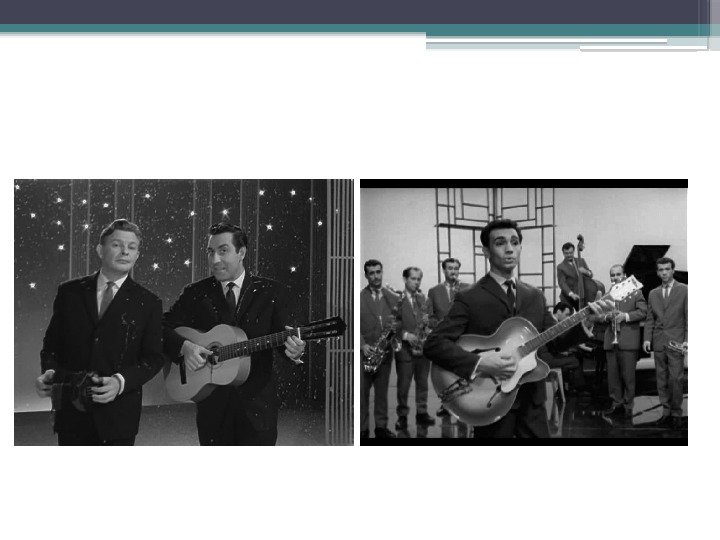
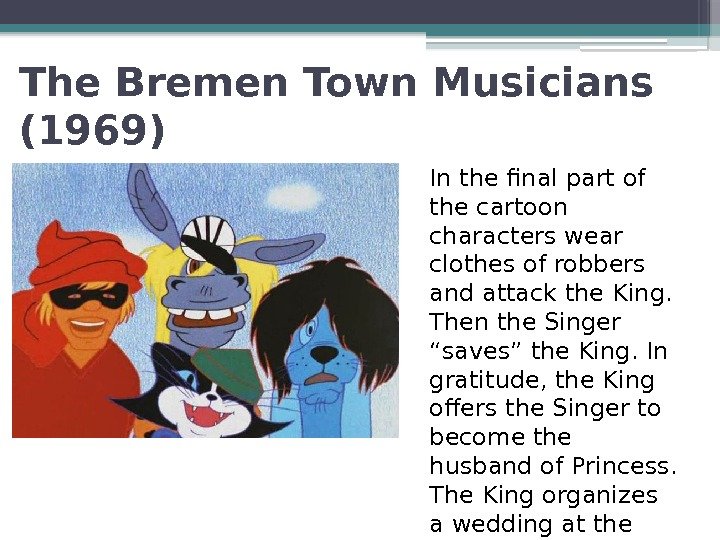
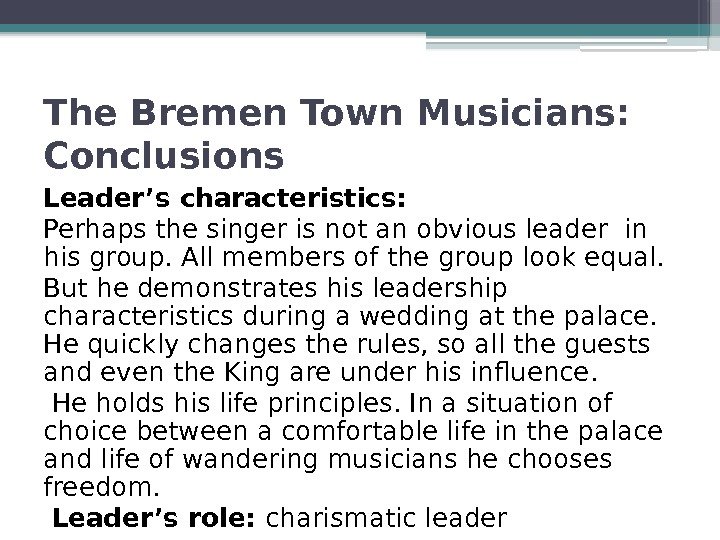
cartoons.pptx
- Размер: 2.8 Мб
- Автор:
- Количество слайдов: 24
Описание презентации The image of leader in the Russian cartoons по слайдам
 The image of leader in the Russian cartoons
The image of leader in the Russian cartoons
 Preliminary remarks Object of analysis : the cartoons that have been created for children, not for adults. The presented cartoons were not selected randomly and don’t constitute a representative sample. All cartoons were created in the 1950 -60, but they are popular nowadays in Russia. The purpose : to explore different images of leaders, different conditions for arising leadership and the relationships within the groups. All cartoons were created in the main animation studio in Russia — «Union’s cartoons» («Soyuzmulfilm» in Russian — http: //soyuzmultfilm. ru/ ).
Preliminary remarks Object of analysis : the cartoons that have been created for children, not for adults. The presented cartoons were not selected randomly and don’t constitute a representative sample. All cartoons were created in the 1950 -60, but they are popular nowadays in Russia. The purpose : to explore different images of leaders, different conditions for arising leadership and the relationships within the groups. All cartoons were created in the main animation studio in Russia — «Union’s cartoons» («Soyuzmulfilm» in Russian — http: //soyuzmultfilm. ru/ ).
 Wonder Mill (1950)
Wonder Mill (1950)
 Wonder Mill: content An old man lived in a small house. А cat and a rooster lived here too. You can see the old man separates the wheat grains from the stems. Rain begins. The old man asks the cat and the rooster to help him to carry the wheat into the house to keep it dry. Somebody’s knocking on the door. The old man asks the rooster to open the door for guests. The bear and the hare asked the old man to allow them to stay in the house. Now — the next visitor, a hedgehog. The old man counts the number of guests, to share the bread equally among all. Suddenly a squirrel comes. A problem arises: where to get bread to feed everyone? The old man says that he has grains, but hasn’t flour to bake bread. It is necessary to make the mill to produce flour from grain.
Wonder Mill: content An old man lived in a small house. А cat and a rooster lived here too. You can see the old man separates the wheat grains from the stems. Rain begins. The old man asks the cat and the rooster to help him to carry the wheat into the house to keep it dry. Somebody’s knocking on the door. The old man asks the rooster to open the door for guests. The bear and the hare asked the old man to allow them to stay in the house. Now — the next visitor, a hedgehog. The old man counts the number of guests, to share the bread equally among all. Suddenly a squirrel comes. A problem arises: where to get bread to feed everyone? The old man says that he has grains, but hasn’t flour to bake bread. It is necessary to make the mill to produce flour from grain.
 Questions for reflection 1) Who is a leader and what are his characteristics? 2) Which are relations between a leader and members of group? 3) What methods of power are used by a leader? 4) Which is a role of leader?
Questions for reflection 1) Who is a leader and what are his characteristics? 2) Which are relations between a leader and members of group? 3) What methods of power are used by a leader? 4) Which is a role of leader?
 Wonder Mill: content If you watched this cartoon to the end, you would see that the old man together with a cat and a rooster solve this problem successfully. They find millstones, which are the most important parts for the mill. And then group’s members are doing other parts of the mill. Finally the old man collects all details together and completes group’s work.
Wonder Mill: content If you watched this cartoon to the end, you would see that the old man together with a cat and a rooster solve this problem successfully. They find millstones, which are the most important parts for the mill. And then group’s members are doing other parts of the mill. Finally the old man collects all details together and completes group’s work.
 Wonder Mill: Conclusions Leader’s characteristics: the leader differs from other group members. The group members perceive the leader as a person who is able to satisfy their vital needs in food and protection. The leader knows how to solve the problems faced by the group. He organizes the coordinated work of the group. The needs of the group members are important for the leader.
Wonder Mill: Conclusions Leader’s characteristics: the leader differs from other group members. The group members perceive the leader as a person who is able to satisfy their vital needs in food and protection. The leader knows how to solve the problems faced by the group. He organizes the coordinated work of the group. The needs of the group members are important for the leader.
 Wonder Mill: Conclusions Relationships between the leader and group members: The leader relies on the assistance of the group members. Team members show loyalty — they immediately respond to the call of the leader. Methods of power: The leader does not use harsh methods of influence, when he needs to encourage group members to do something together. Leader’s role: Leader — caring father (grandfather)
Wonder Mill: Conclusions Relationships between the leader and group members: The leader relies on the assistance of the group members. Team members show loyalty — they immediately respond to the call of the leader. Methods of power: The leader does not use harsh methods of influence, when he needs to encourage group members to do something together. Leader’s role: Leader — caring father (grandfather)
 Mushroom-Mansion (1958)
Mushroom-Mansion (1958)
 Mushroom-Mansion: content An ant symbolizes a good worker in the Russian fairy tales. The grasshopper warns the ant about the thunderstorm. A butterfly asks the ant to allow her to hide under the mushroom. First the ant says that there is very little space under the mushroom even for him. But then he allows the butterfly to hide under the mushroom. Ant and butterfly sing that they are happy, because they do not get wet in the rain. A mouse comes. The situation is repeated. The weather is getting worse. It begins hail. A sparrow comes.
Mushroom-Mansion: content An ant symbolizes a good worker in the Russian fairy tales. The grasshopper warns the ant about the thunderstorm. A butterfly asks the ant to allow her to hide under the mushroom. First the ant says that there is very little space under the mushroom even for him. But then he allows the butterfly to hide under the mushroom. Ant and butterfly sing that they are happy, because they do not get wet in the rain. A mouse comes. The situation is repeated. The weather is getting worse. It begins hail. A sparrow comes.
 Mushroom-Mansion: content A hare asks to save him and to allow him to hide under the mushroom. The fox chasing him. The ant says that the hare is too large, so he can not fit under the mushroom. The ant discuss this situation with other group members. He says that someone has to come out, then the hare will be able to hide. But it is dangerous, because the fox is near. First the butterfly says she can get out of the mushroom, then the mouse says , then the sparrow says. But the ant decides to go out and meet with the fox. Finally, the ant jumps on the fox’s nose and bites her. The fox escapes. Happy end.
Mushroom-Mansion: content A hare asks to save him and to allow him to hide under the mushroom. The fox chasing him. The ant says that the hare is too large, so he can not fit under the mushroom. The ant discuss this situation with other group members. He says that someone has to come out, then the hare will be able to hide. But it is dangerous, because the fox is near. First the butterfly says she can get out of the mushroom, then the mouse says , then the sparrow says. But the ant decides to go out and meet with the fox. Finally, the ant jumps on the fox’s nose and bites her. The fox escapes. Happy end.
 Mushroom-Mansion: Conclusions Leader’s characteristics: The leader is similar to other group members, he is one of them. Physically, he is less than the other group members. But he has the resources, which others need. Leader understands the needs of group members, because he had a similar experience. And he is willing to share with them his resources to help them.
Mushroom-Mansion: Conclusions Leader’s characteristics: The leader is similar to other group members, he is one of them. Physically, he is less than the other group members. But he has the resources, which others need. Leader understands the needs of group members, because he had a similar experience. And he is willing to share with them his resources to help them.
 Mushroom-Mansion: Conclusions Relationships between the leader and group members: The leader cares about the members of the group. He does not want to expose their lives in danger. He risks his own life for the welfare of others. Methods of power: The leader organizes a group discussion to make important decisions. He listens to the opinions of all group members and only after that he takes the final decision. He is the democratic leader (according to the typology of Kurt Lewin), or leader, who performs an I-function (Integration) (in accordance with the PAEI model by I. Adizes). Leader’s role: Leader-hero.
Mushroom-Mansion: Conclusions Relationships between the leader and group members: The leader cares about the members of the group. He does not want to expose their lives in danger. He risks his own life for the welfare of others. Methods of power: The leader organizes a group discussion to make important decisions. He listens to the opinions of all group members and only after that he takes the final decision. He is the democratic leader (according to the typology of Kurt Lewin), or leader, who performs an I-function (Integration) (in accordance with the PAEI model by I. Adizes). Leader’s role: Leader-hero.
 Adventure of funny little men: Exactly at 3: 15 (1959)
Adventure of funny little men: Exactly at 3: 15 (1959)
 Adventure of funny little men: Exactly at 3: 15 (1959) The phone rings. All little men look at Chairman Pencil. He picks up the phone. He talks to a person from the children’s summer camp who invites funny little men to take part in a concert for children. Chairman Pencil says that he need to consult with others. Then he informs team members about the time when a concert starts and asks them if they are ready to take part. The children in the summer camp read the announcement of the concert with funny little men. They are waiting for the concert. It should begin at 3: 15 pm.
Adventure of funny little men: Exactly at 3: 15 (1959) The phone rings. All little men look at Chairman Pencil. He picks up the phone. He talks to a person from the children’s summer camp who invites funny little men to take part in a concert for children. Chairman Pencil says that he need to consult with others. Then he informs team members about the time when a concert starts and asks them if they are ready to take part. The children in the summer camp read the announcement of the concert with funny little men. They are waiting for the concert. It should begin at 3: 15 pm.
 Adventure of funny little men: Exactly at 3: 15 (1959) But the funny little men have a big problem. Their car is broken. And they are late to the beginning of the concert. The Chairmen Pencil does not know what to do. He is confused. He asks: «What can we do? » But team members have not any answer. They say one by one: «I do not know. » But the Skillful little man has a great idea. He proposes to make a scooter, so the Chairman Pencil could drive to the summer camp and open the concert. When the Chairman Pencil leaves, two members of the group: Petrushka and Buratino begin to argue who is a leader now. Again, Skillful little man makes decision to finish the dispute.
Adventure of funny little men: Exactly at 3: 15 (1959) But the funny little men have a big problem. Their car is broken. And they are late to the beginning of the concert. The Chairmen Pencil does not know what to do. He is confused. He asks: «What can we do? » But team members have not any answer. They say one by one: «I do not know. » But the Skillful little man has a great idea. He proposes to make a scooter, so the Chairman Pencil could drive to the summer camp and open the concert. When the Chairman Pencil leaves, two members of the group: Petrushka and Buratino begin to argue who is a leader now. Again, Skillful little man makes decision to finish the dispute.
 Adventure of funny little men: Conclusions Leader’s characteristics: It may seem that funny little men have only one leader — Chairman Pencil. But in a difficult situation, Chairman Pencil can not solve the group’s problem. The second leader is Skillful little man. He offers a solution to the problem. When funny little men go to the children’s summer camp by car, we can see that two leaders supplement each other. Chairman Pencil organizes coordinated actions of the group members and inspires them. Skillful little man is driving. Thanks to him, the group moves to its goal.
Adventure of funny little men: Conclusions Leader’s characteristics: It may seem that funny little men have only one leader — Chairman Pencil. But in a difficult situation, Chairman Pencil can not solve the group’s problem. The second leader is Skillful little man. He offers a solution to the problem. When funny little men go to the children’s summer camp by car, we can see that two leaders supplement each other. Chairman Pencil organizes coordinated actions of the group members and inspires them. Skillful little man is driving. Thanks to him, the group moves to its goal.
 Adventure of funny little men: Conclusions Relationships between the leader and group members: Funny little men look strongly dependent on the Chairman Pencil (all except Skillful little man). They do not show initiative and are awaiting actions from the leader. Methods of power: Chairman Pencil involves team members in the group discussion and consults with them. But in a difficult situation, team members can not provide any ideas.
Adventure of funny little men: Conclusions Relationships between the leader and group members: Funny little men look strongly dependent on the Chairman Pencil (all except Skillful little man). They do not show initiative and are awaiting actions from the leader. Methods of power: Chairman Pencil involves team members in the group discussion and consults with them. But in a difficult situation, team members can not provide any ideas.
 Adventure of funny little men: Conclusions Leader’s role: leader — inspiring person (Chairman Pencil), leader- intellectual and skillful person (Skillful little man). The situation with the two leaders reflects the idea of Adizes that there is no leader who would be able to carry out all the functions to ensure effective management. Therefore, a team of leaders is more efficient than one leader.
Adventure of funny little men: Conclusions Leader’s role: leader — inspiring person (Chairman Pencil), leader- intellectual and skillful person (Skillful little man). The situation with the two leaders reflects the idea of Adizes that there is no leader who would be able to carry out all the functions to ensure effective management. Therefore, a team of leaders is more efficient than one leader.
 The Bremen Town Musicians ( 1969)
The Bremen Town Musicians ( 1969)
 The Bremen Town Musicians ( 1969) In the first part of the cartoon you can see the main characters: Singer and his friends: a Donkey, a Dog, a Cat and a Rooster. All they are the musicians. They go to the city to show the performance for citizens. Singer sings how well is to travel and to be free. His friends join him and sing together. In the next part you will see a performance of the musicians. Their actions are coordinated with each other. And there isn’t anyone who would have organized group activities.
The Bremen Town Musicians ( 1969) In the first part of the cartoon you can see the main characters: Singer and his friends: a Donkey, a Dog, a Cat and a Rooster. All they are the musicians. They go to the city to show the performance for citizens. Singer sings how well is to travel and to be free. His friends join him and sing together. In the next part you will see a performance of the musicians. Their actions are coordinated with each other. And there isn’t anyone who would have organized group activities.

 The Bremen Town Musicians (1969) In the final part of the cartoon characters wear clothes of robbers and attack the King. Then the Singer “saves” the King. In gratitude, the King offers the Singer to become the husband of Princess. The King organizes a wedding at the palace.
The Bremen Town Musicians (1969) In the final part of the cartoon characters wear clothes of robbers and attack the King. Then the Singer “saves” the King. In gratitude, the King offers the Singer to become the husband of Princess. The King organizes a wedding at the palace.
 The Bremen Town Musicians: Conclusions Leader’s characteristics: Perhaps the singer is not an obvious leader in his group. All members of the group look equal. But he demonstrates his leadership characteristics during a wedding at the palace. He quickly changes the rules, so all the guests and even the King are under his influence. He holds his life principles. In a situation of choice between a comfortable life in the palace and life of wandering musicians he chooses freedom. Leader’s role: charismatic leader
The Bremen Town Musicians: Conclusions Leader’s characteristics: Perhaps the singer is not an obvious leader in his group. All members of the group look equal. But he demonstrates his leadership characteristics during a wedding at the palace. He quickly changes the rules, so all the guests and even the King are under his influence. He holds his life principles. In a situation of choice between a comfortable life in the palace and life of wandering musicians he chooses freedom. Leader’s role: charismatic leader
